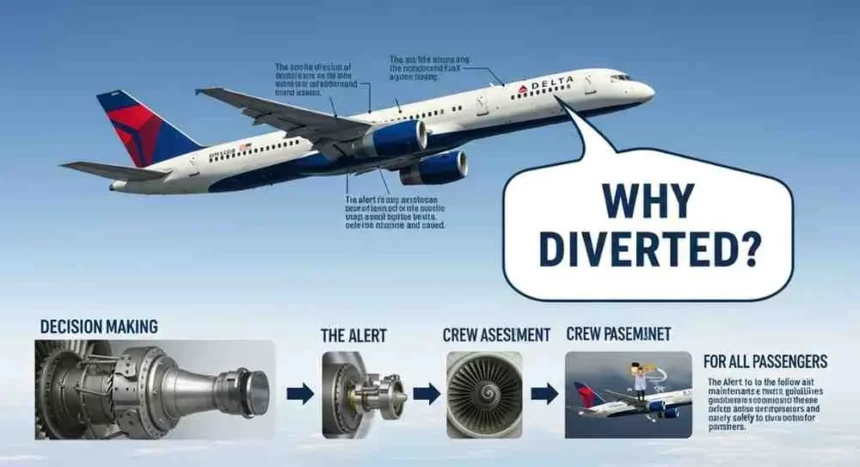On May 28, 2025, Delta Flight DL275 diverted LAX after a serious engine issue forced an emergency landing at Runway 06R, creating a real-time aviation drama that aviation enthusiasts worldwide followed on Flightradar24. What began as a routine 13-hour journey from Detroit to Tokyo transformed into a $2.3 million operational crisis that highlighted the complex decision-making processes behind flight diverting to LAX.
This comprehensive analysis examines why delta flight dl275 diverted lax, the technical factors that influenced this decision, and what it reveals about modern airline operations, maintenance logistics, and passenger safety protocols. From anti-ice system failures to strategic maintenance hub selection, readers will understand the intricate world of aviation safety and operational decision-making.
Key Reasons Flights Divert to LAX
Los Angeles International Airport serves as a critical diversion destination for airlines operating long-haul routes over the Pacific. Understanding why flight diverted to LAX requires examining multiple operational factors that make LAX an attractive emergency destination.
Strategic Geographic Position: LAX’s location on the West Coast makes it an ideal diversion point for trans-Pacific flights experiencing technical difficulties. Originally cruising at 38,000 feet over the North Pacific, the aircraft was approximately 620 nautical miles southwest of Anchorage when flight crews made the call, demonstrating how flight path geometry influences diversion decisions.
Comprehensive Infrastructure: LAX offers extensive runway capacity, with multiple long runways capable of handling widebody aircraft like the A350. The airport’s 24/7 operations ensure that diverted flights receive immediate attention regardless of arrival time, a critical factor for emergency situations.
Maintenance Capabilities: LAX serves as a major Delta hub with certified Airbus A350 maintenance facilities, 24/7 Rolls-Royce engine specialists, making it the logical choice when technical issues require immediate expert attention. This infrastructure advantage explains why would a flight divert to LAX for maintenance rather than continuing to alternate airports.
Weather Advantages: Southern California’s consistently mild weather provides optimal conditions for aircraft maintenance and passenger comfort during extended ground delays. Unlike northern airports that might experience severe weather conditions, LAX offers reliable operating conditions year-round.
The Case of DL275—Anti-Ice System Failure
Engine De-icing Issue Flight Explained
Delta flight DL275 from Detroit (DTW) to Tokyo (HND) diverted to Los Angeles (LAX) due to an A350 engine anti-ice system issue involving the anti-ice system of one of the Rolls-Royce Trent XWB engines powering the Airbus A350. This engine de-icing issue flight scenario represents one of the most serious technical malfunctions that can affect aircraft operations over oceanic routes.
Understanding Anti-Ice Systems: Aircraft anti-ice systems prevent ice formation on critical engine components, particularly the engine intake and nacelle areas. These systems use hot bleed air from the engine compressor to maintain surface temperatures above freezing, ensuring proper airflow and engine performance.
Failure Implications: When anti-ice systems fail, aircraft face severe operational limitations. Ice accumulation can disrupt engine airflow, reduce thrust output, and potentially cause engine damage or flame-out. For flights operating over cold oceanic regions, functional anti-ice systems are absolutely critical for safety.
Flight Crew Decision Process: The flight DL275 departed Detroit gate A46 yesterday for a 13-hour flight to Tokyo Haneda Airport but while flying over the Bering Sea, the crew decided to turn over for a reason still unknown, highlighting how pilots must make rapid decisions when critical systems fail over remote oceanic areas.
The Bering Sea region presents particularly challenging conditions for aircraft with anti-ice system failures. Cold temperatures, potential icing conditions, and limited diversion options force flight crews to act decisively to ensure passenger safety.
Why LAX Maintenance Hub Is Preferred
Specialized A350 Capabilities: LAX serves as a major Delta hub with certified Airbus A350 maintenance facilities, 24/7 Rolls-Royce engine specialists, providing immediate access to qualified technicians familiar with Trent XWB engine systems. This specialization is crucial when dealing with complex anti-ice system malfunctions.
Parts Availability: Major maintenance hubs like LAX maintain extensive parts inventories for commonly operated aircraft types. For A350 operations, this means immediate access to engine components, sensors, and specialized tools required for anti-ice system repairs.
Regulatory Compliance: Delta LAX maintenance hangar operations maintain appropriate certifications for conducting complex engine maintenance on widebody aircraft. These certifications ensure that repairs meet all regulatory requirements before aircraft return to service.
Operational Integration: As a Delta hub, LAX offers seamless integration between maintenance operations and flight operations. This coordination enables efficient passenger re-accommodation, crew scheduling, and aircraft repositioning once repairs are completed.
LAX vs SEA for A350 Maintenance

Crew Base & Hangar Comparisons
The question “wouldn’t SEA be better for A350 maintenance?” frequently arises when analyzing Pacific route diversions. While Seattle-Tacoma International Airport offers certain geographical advantages, several factors favor LAX for maintenance operations.
Maintenance Infrastructure Comparison:
- LAX Advantages: Dedicated Delta maintenance hangars, established Rolls-Royce support network, extensive parts inventory
- SEA Considerations: Limited widebody maintenance capacity, fewer specialized A350 technicians, smaller parts inventory
Crew Base Logistics: LAX aircraft crew base operations provide immediate access to qualified flight crews for aircraft repositioning and continued operations. This crew availability becomes critical when diversions create scheduling disruptions affecting multiple flights.
Hangar Capacity: A350 maintenance hub LAX facilities offer dedicated space for widebody aircraft maintenance, while Seattle’s maintenance capacity focuses primarily on Boeing aircraft operations. This specialization difference significantly impacts repair timelines and technical expertise availability.
Warm-Weather Advantages
Engine Performance: Cold-weather maintenance operations face additional challenges when working on temperature-sensitive components like anti-ice systems. LAX’s mild climate provides optimal conditions for system testing and calibration procedures.
Operational Efficiency: Warm weather reduces ground equipment requirements, minimizes weather-related delays, and enables more efficient maintenance operations. These factors contribute to faster repair turnaround times and reduced operational costs.
Passenger Comfort: Extended ground delays in mild Southern California weather prove more comfortable for passengers compared to potentially harsh conditions at northern airports. This consideration factors into airline decision-making processes during emergency situations.
Airline Diversion Procedures & Passenger Impact
Emergency vs Procedural Diversion
Emergency Diversion Classification: While flight diverted due to engine freezing announcement might suggest an emergency situation, most anti-ice system failures fall under “procedural diversions” rather than true emergencies. This classification affects air traffic control handling, airport response, and passenger communication.
Decision-Making Timeline: The Airbus A350-900, with registration N508DN, flew during 5 hours to reach Los Angeles Airport, demonstrating how flight crews balance immediate safety needs with operational efficiency when selecting diversion airports.
Communication Protocols: Airlines follow specific procedures for notifying passengers about diversions. These communications must balance transparency with passenger anxiety management, particularly when technical failures involve critical safety systems.
Regulatory Requirements: Aircraft diversion procedures mandate specific reporting requirements to aviation authorities, documentation of technical failures, and coordination with maintenance personnel at diversion airports.
Great Circle Route Considerations
Flight Path Analysis: Great circle route LAX HND A350 operations typically follow optimized paths that minimize flight time and fuel consumption. When diversions become necessary, pilots must consider multiple factors including remaining fuel, weather conditions, and airport capabilities.
Fuel Considerations: Long-haul flights carry fuel for their planned route plus required reserves. Diversions alter fuel consumption patterns and may require fuel dumping or additional fuel stops depending on circumstances and aircraft weight.
Route Optimization: Flight routing northern Pacific operations follow established airways and waypoints. During diversions, air traffic control must coordinate new routing that maintains separation from other aircraft while accommodating the emergency aircraft’s needs.
Case Studies and Real-World Examples

DL275 Flightradar24 Analysis
Delta flight DL275 diverted LAX on May 28, 2025, creating a 12-hour aviation crisis that aviation enthusiasts tracked in real-time through flight tracking platforms. This incident provides valuable insights into modern airline operations and decision-making processes.
Flight Tracking Data: Public flight tracking revealed the aircraft’s path over the Bering Sea, the decision point for diversion, and the subsequent five-hour flight to LAX. This data demonstrates how modern technology enables real-time monitoring of aviation incidents.
Timeline Reconstruction: This exclusive minute-by-minute reconstruction reveals the complexity of airline operational decisions during technical emergencies. Each decision point involves multiple stakeholders including flight crew, dispatch, maintenance, and air traffic control.
Cost Analysis: The Delta flight DL275 diverted LAX incident generated substantial costs across multiple categories with revenue loss from the cancelled Tokyo segment reaching $1.9 million, while network disruption effects cascaded through the system, contributing to the total $2.3 million cost.
Comparison to Other Widebody Diversions
Historical Context: Widebody diversion logistics have evolved significantly with improved communication systems, better weather forecasting, and enhanced maintenance capabilities at major airports. The DL275 incident represents modern best practices in diversion management.
Industry Patterns: Similar diversions involving A350 aircraft typically follow predictable patterns based on route structure, maintenance hub locations, and technical support availability. LAX consistently ranks among preferred diversion destinations for Pacific operations.
Operational Learning: Each diversion incident contributes to industry knowledge about optimal decision-making processes, maintenance procedures, and passenger care protocols during extended delays.
Top Reasons Flights Divert to LAX
Understanding aircraft diversion reasons helps passengers and aviation enthusiasts appreciate the complexity of airline operations. Here are the primary factors driving diversion decisions:
Technical Malfunctions: Engine problems, hydraulic failures, electrical issues, and other mechanical malfunctions requiring immediate maintenance attention represent the most common diversion triggers.
Medical Emergencies: Passenger or crew medical emergencies requiring immediate hospitalization lead to diversions to airports with appropriate medical facilities and emergency response capabilities.
Weather Conditions: Severe weather at destination airports, including thunderstorms, high winds, or poor visibility conditions, may force diversions to alternate airports with better weather conditions.
Security Concerns: Unruly passengers, security threats, or other safety concerns may require immediate landing at airports equipped to handle security situations.
Fuel Considerations: Unexpected headwinds, weather diversions, or holding patterns may require fuel stops at intermediate airports to maintain required fuel reserves.
Airport Closures: Runway closures, air traffic control strikes, or emergency situations at destination airports necessitate diversions to alternate facilities.
Crew Duty Time: Flight and cabin crew duty time limitations may require diversions when flights experience significant delays that would exceed regulatory limits.
Frequently Asked Questions

“Wouldn’t SEA Be Better for A350 Maintenance?”
Seattle vs LAX aircraft maintenance capabilities differ significantly for widebody international aircraft. While Seattle offers geographical advantages for certain Pacific routes, LAX provides superior A350-specific maintenance infrastructure.
Maintenance Facility Comparison: LAX maintains dedicated Airbus maintenance facilities with specialized A350 capabilities, while Seattle focuses primarily on Boeing aircraft operations. This specialization gap significantly impacts repair timelines and technical expertise availability.
Parts and Supply Chain: Delta maintenance operation hubs at LAX benefit from established supply chains optimized for Airbus aircraft operations. Parts availability, shipping logistics, and vendor relationships all favor LAX for A350 maintenance operations.
Technical Expertise: Rolls-Royce engine specialists and Airbus-certified technicians maintain regular presence at LAX, providing immediate access to qualified personnel familiar with Trent XWB engine systems and A350 aircraft systems.
“Why Choose LAX Over SEA for Crew Base?”
Crew Scheduling Efficiency: LAX aircraft crew base operations provide larger pools of qualified international pilots and cabin crew members. This depth enables more efficient crew scheduling during irregular operations and equipment diversions.
Training Facilities: LAX-area training facilities offer comprehensive A350 type rating programs and recurrent training capabilities. This infrastructure supports crew proficiency and regulatory compliance requirements.
Operational Flexibility: Larger crew bases provide greater scheduling flexibility during disruptions, enabling faster recovery from operational irregularities and equipment diversions.
“Does LAX Have A350 Heavy Maintenance Facilities?”
Heavy Maintenance Capabilities: Does LAX have A350 heavy maintenance facilities is a common question among aviation enthusiasts. LAX mai




